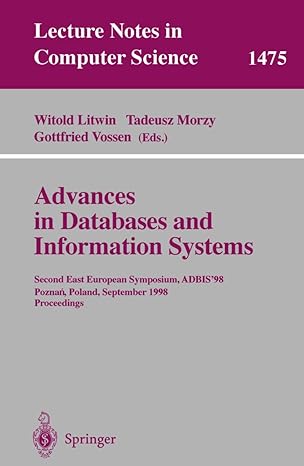Question
This project consists of designing a C program to serve as a shell interface that accepts user commands and then executes each command in a
This project consists of designing a C program to serve as a shell interface that accepts user commands and then executes each command in a separate process. This project can be completed on any Linux, UNIX,or Mac OS X system.
A shell interface gives the user a prompt, after which the next command is entered. The example below illustrates the prompt osh> and the users next command: cat prog.c. (This command displays the le prog.c on the terminal using the UNIX cat command.
osh> cat prog.c
One technique for implementing a shell interface is to have the parent process rst read what the user enters on the command line (in this case, cat prog.c), and then create a separate child process that performs the command. Unless otherwise specied, the parent process waits for the child to exit before continuing. This is similar in functionality to the new process creation illustrated in Figure 3.10. However, UNIX shells typically also allow the child process to run in the background, or concurrently. To accomplish this, we add an ampersand (&) at the end of the command. Thus, if we rewrite the above command as
osh> cat prog.c &
the parent and child processes will run concurrently.
The separate child process is created using the fork() system call, and the
users command is executed using one of the system calls in the exec() family
(as described in Section 3.3.1).
A C program that provides the general operations of a command-line shell is supplied in Figure 3.36. The main() function presents the prompt osh-> and outlines the steps to be taken after input from the user has been read. The main() function continually loops as long as should run equals 1; when the user enters exit at the prompt, your program will set should run to 0 and terminate.
This project is organized into two parts: (1) creating the child process and executing the command in the child, and (2) modifying the shell to allow a history feature
#include
#include
#define MAX LINE 80 /* The maximum length command */
int main(void)
{
char *args[MAX LINE/2 + 1]; /* command line arguments */
int should run = 1; /* flag to determine when to exit program */
while (should run) {
printf("osh>");
fflush(stdout);
/**
* After reading user input, the steps are:
* (1) fork a child process using fork()
* (2) the child process will invoke execvp()
* (3) if command included &, parent will invoke wait()
*/
}
return 0;
The rst task is to modify the main() function in Figure 3.36 so that a child process is forked and executes the command specied by the user. This will require parsing what the user has entered into separate tokens and storing the tokens in an array of character strings (args in Figure 3.36). For example, if the user enters the command ps -ael at the osh> prompt, the values stored in the args array are:
args[0] = "ps"
args[1] = "-ael"
args[2] = NULL
The rst task is to modify the main() function in Figure 3.36 so that a child process is forked and executes the command specied by the user. This will require parsing what the user has entered into separate tokens and storing the tokens in an array of character strings (args in Figure 3.36). For example, if the user enters the command ps -ael at the osh> prompt, the values stored in the args array are:
args[0] = "ps"
args[1] = "-ael"
args[2] = NULL
The next task is to modify the shell interface program so that it provides a history feature that allows the user to access the most recently entered commands. The user will be able to access up to 10 commands by using the feature. The commands will be consecutively numbered starting at 1, and the numbering will continue past 10. For example, if the user has entered 35 commands, the 10 most recent commands will be numbered 26 to 35.
The user will be able to list the command history by entering the command
history
at the osh> prompt. As an example, assume that the history consists of the commands (from most to least recent):
ps, ls -l, top, cal, who, date
The command history will output:
6ps
5ls-l
4 top
3 cal
2 who
1 date
Your program should support two techniques for retrieving commands from the command history:
1.
When the user enters !!, the most recent command in the history is executed.
2.
When the user enters a single ! followed by an integer N, the N^th
command in the history is executed.
Continuing our example from above, if the user enters !!,the ps command will be performed; if the user enters !3, the command cal will be executed. Any command executed in this fashion should be echoed on the users screen. The command should also be placed in the history buffer as the next command.
The program should also manage basic error handling. If there are no commands in the history, entering !! should result in a message No commands in history. If there is no command corresponding to the number entered with the single !, the program should output "No such command in history."
Step by Step Solution
There are 3 Steps involved in it
Step: 1

Get Instant Access to Expert-Tailored Solutions
See step-by-step solutions with expert insights and AI powered tools for academic success
Step: 2

Step: 3

Ace Your Homework with AI
Get the answers you need in no time with our AI-driven, step-by-step assistance
Get Started


